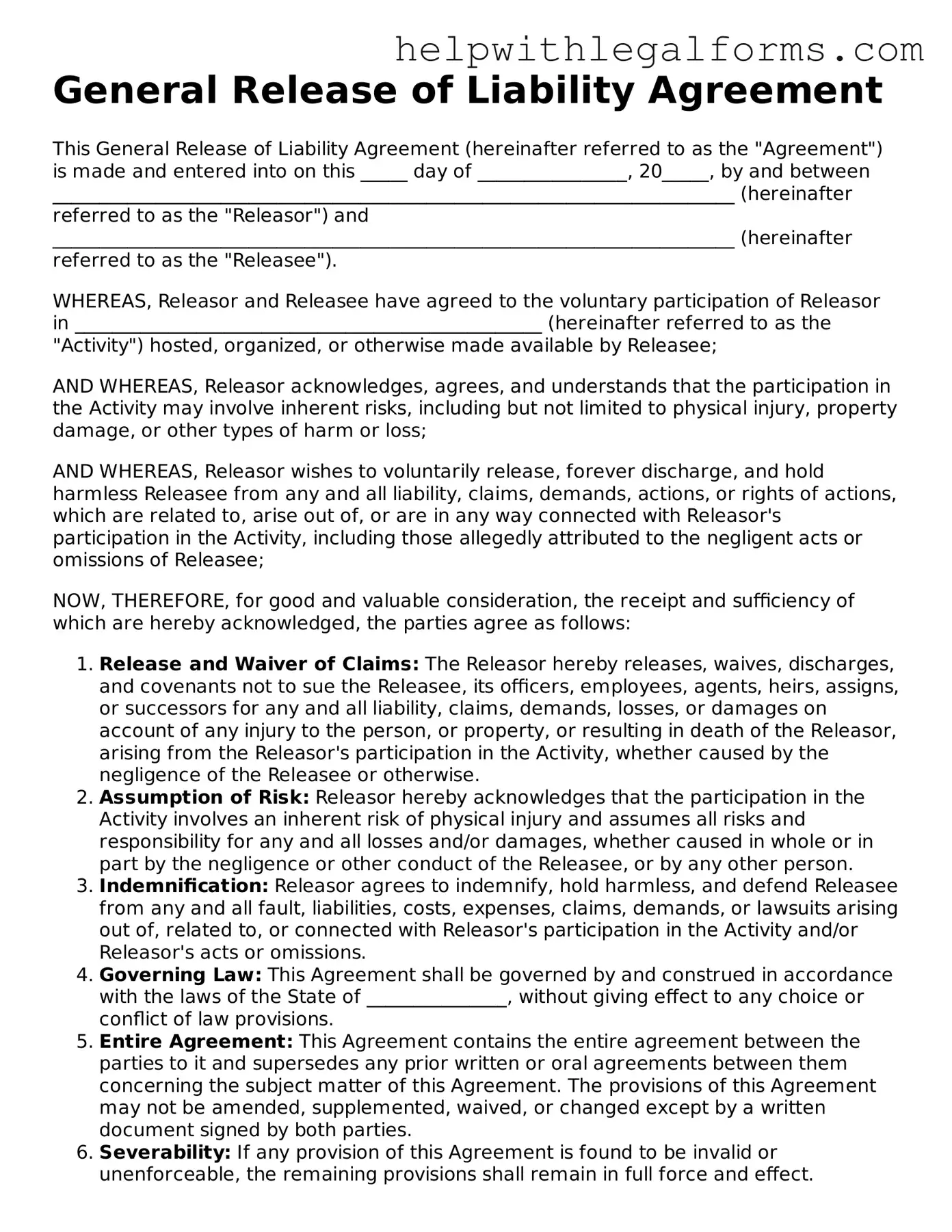General Release of Liability Agreement
This General Release of Liability Agreement (hereinafter referred to as the "Agreement") is made and entered into on this _____ day of ________________, 20_____, by and between _________________________________________________________________________ (hereinafter referred to as the "Releasor") and _________________________________________________________________________ (hereinafter referred to as the "Releasee").
WHEREAS, Releasor and Releasee have agreed to the voluntary participation of Releasor in __________________________________________________ (hereinafter referred to as the "Activity") hosted, organized, or otherwise made available by Releasee;
AND WHEREAS, Releasor acknowledges, agrees, and understands that the participation in the Activity may involve inherent risks, including but not limited to physical injury, property damage, or other types of harm or loss;
AND WHEREAS, Releasor wishes to voluntarily release, forever discharge, and hold harmless Releasee from any and all liability, claims, demands, actions, or rights of actions, which are related to, arise out of, or are in any way connected with Releasor's participation in the Activity, including those allegedly attributed to the negligent acts or omissions of Releasee;
NOW, THEREFORE, for good and valuable consideration, the receipt and sufficiency of which are hereby acknowledged, the parties agree as follows:
- Release and Waiver of Claims: The Releasor hereby releases, waives, discharges, and covenants not to sue the Releasee, its officers, employees, agents, heirs, assigns, or successors for any and all liability, claims, demands, losses, or damages on account of any injury to the person, or property, or resulting in death of the Releasor, arising from the Releasor's participation in the Activity, whether caused by the negligence of the Releasee or otherwise.
- Assumption of Risk: Releasor hereby acknowledges that the participation in the Activity involves an inherent risk of physical injury and assumes all risks and responsibility for any and all losses and/or damages, whether caused in whole or in part by the negligence or other conduct of the Releasee, or by any other person.
- Indemnification: Releasor agrees to indemnify, hold harmless, and defend Releasee from any and all fault, liabilities, costs, expenses, claims, demands, or lawsuits arising out of, related to, or connected with Releasor's participation in the Activity and/or Releasor's acts or omissions.
- Governing Law: This Agreement shall be governed by and construed in accordance with the laws of the State of _______________, without giving effect to any choice or conflict of law provisions.
- Entire Agreement: This Agreement contains the entire agreement between the parties to it and supersedes any prior written or oral agreements between them concerning the subject matter of this Agreement. The provisions of this Agreement may not be amended, supplemented, waived, or changed except by a written document signed by both parties.
- Severability: If any provision of this Agreement is found to be invalid or unenforceable, the remaining provisions shall remain in full force and effect.
- Acknowledgment of Understanding: Releasor has read this Agreement, fully understands its terms, understands that Releasor has given up substantial rights by signing it and has signed it freely and without any inducement or assurance of any nature. Releasor intends it to be a complete and unconditional release of all liability to the greatest extent allowed by law. Releasor affirms that no oral representations, statements, or inducements apart from the foregoing written agreement have been made.
IN WITNESS WHEREOF, the parties hereto have executed this General Release of Liability Agreement on the date first above written.
Releasor's Signature: ___________________________________________
Print Name: ___________________________________________________
Date: _________________________________________________________
Releasee's Signature: __________________________________________
Print Name: ___________________________________________________
Date: _________________________________________________________
